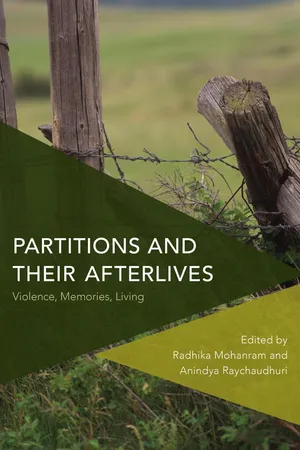
Partitions and Their Afterlives
Violence, Memories, Living
- 250 pages
- English
- PDF
- Available on iOS & Android
About This Book
How can we theorise partitions differently? How are new identities, moralities, polities and life constructed post-partition? How are gender and sexuality recalibrated after partition? How can violence be theorised? What is the relationship between identity in the diaspora and identity after partition? What is the relationship between the movement of capital and national borders that is the mark of partition? Partitions and their Afterlives engages with political partitions and how their aftermath affects the contemporary life of nations and their citizens. Using a comparative perspective, the essays seek to stretch our understanding of these conflicts and to show how elements of our day-to-day lives have been shaped by them. In juxtaposing the various partitions in a single volume the book contributes to debates on citizenship, collective memory, nation-building, and borders and boundaries. Such a focus also reveals how local communities as well as nations use their knowledge of the past and history. This ground-breaking multi-disciplinary and multi-region volume will analyse the various convergences and departures between the different partitions and draw out lessons for the present. In so doing, this work will also examine methodological challenges and the imperatives for scholars working on individual countries.
Frequently asked questions
Information
Table of contents
- Contents
- Acknowledgments
- Introduction
- Chapter 1. The 1947 Partition Violence: Characteristics and Interpretations
- Chapter 2. The Sociohistorical Production of Partition in Palestine
- Chapter 3. Sexuality after Partition: The Great Indian Private Sphere
- Chapter 4. Lessons Not Learned from the Yugoslav Dismemberment and Their Implications for the European Union
- Chapter 5. Legacies of Partition: Remembering the German Democratic Republic
- Chapter 6. Memory Wars and Identity Construction: Return of the Suppressed as Afterlife of Partition under the Hindutva Rule in India
- Chapter 7. Postpartition Anxieties and the Matter of Authenticity in Ireland
- Chapter 8. Drawing Partition and Its Violence: Joe Sacco’s Palestine and Vishwajyoti Ghosh’s This Side, That Side
- Chapter 9. Advertising (Across) Borders: Fetishizing Humanism and the ‘Magic’ of Capitalism
- Chapter 10. Following a Theory of Partition
- Index
- List of Contributors